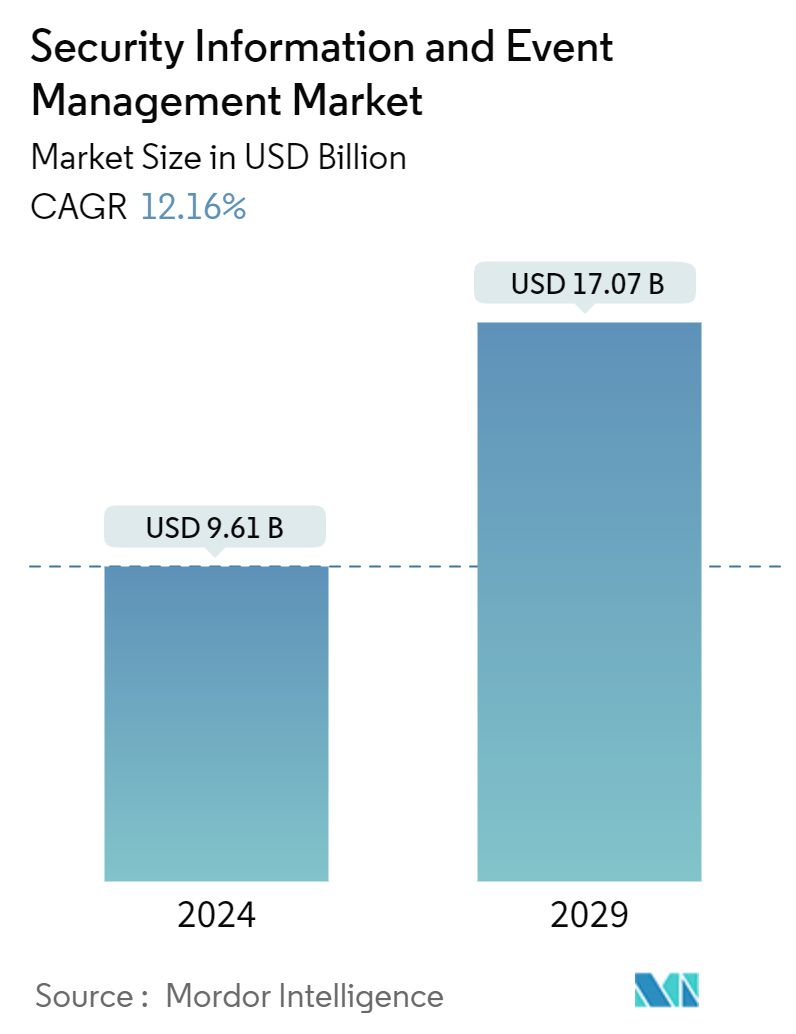
| Study Period | 2019 - 2029 |
| Market Size (2024) | USD 9.61 Billion |
| Market Size (2029) | USD 17.07 Billion |
| CAGR (2024 - 2029) | 12.16 % |
| Fastest Growing Market | Asia Pacific |
| Largest Market | North America |
| Market Concentration | Low |
Major Players
*Disclaimer: Major Players sorted in no particular order |
Security Information And Event Management Market Analysis
The Security Information And Event Management Market size is estimated at USD 9.61 billion in 2024, and is expected to reach USD 17.07 billion by 2029, growing at a CAGR of 12.16% during the forecast period (2024-2029).
Security information and event management (SIEM) tools are vital to the data security ecosystem. They aggregate data from multiple systems and analyze it to catch abnormal behavior or potential cyberattacks. They collect security data from network devices, servers, domain controllers, and more. SIEM stores normalize, aggregate, and apply analytics to that data to discover trends, detect threats, and enable organizations to investigate alerts.
- The first generation of SIEMs, introduced in 2005, combined log management and event management systems, which were previously separate. In the past, SIEMs required diligent management at every stage of the data pipeline, like data ingestion, policies, reviewing alerts, and analyzing anomalies. Increasingly, SIEMs are getting smarter toward pulling data together from more organizational sources and using AI techniques to understand what type of behavior constitutes a security incident.
- The current trend for SIEM has been defined by three capabilities, namely cloud computing (on-demand, extensible services), collaboration (sharing of threat intelligence and analytics), and cognitive technology (artificial intelligence and automation to help in arriving at smarter, faster decision-making).
- Cybercriminals are developing more sophisticated threats and using automation to launch them in high volumes. Organizations are adopting more security tools to help them detect and respond to these threats. However, security tools make it difficult to get a holistic view of the organization’s security posture. This challenge drives an increased adoption of security information and event management (SIEM) tools.
- The trend of adopting your own devices (BYOD) in enterprises is a strong driver for the SIEM market, which is expected to have a significant impact in the long term. In the current mobile world, employees want the freedom to work from anywhere using their mobile phones, tablets, laptops, or wearables. Organizations are adopting BYOD programs to make it happen.
- Security information and event management (SIEM) is one of the major crucial security investments. It helps log, collect, and correlate security events across an organization. However, SIEM is an expensive tool that has always come with a steep price tag. In a survey of 248 tech decision-makers conducted in 2023, the security firm Lokker discovered that over two-thirds of respondents perceive SIEM pricing as a critical issue. However, SIEM is still popular and is viewed by many firms as an important technology for managing cyber threats. Furthermore, almost two-thirds of companies have adopted an SIEM tool and use it mostly for faster threat detection.
Security Information And Event Management Industry Segmentation
Security information and event management is a sophisticated technology that includes mobile devices, cloud, third-party threat intelligence, and traditional sources, such as endpoints, firewalls, system logs, and directory services. SIEM is a tool for gathering data for threat analysis and detecting threats. It is based on real-time analysis of security alerts generated in an organization's IT network applications and infrastructure.
The security information and event management market is segmented by deployment (on-premise, cloud), organization type (small and medium enterprises, large enterprises), end-user industry (retail, BFSI, manufacturing, government, healthcare, other end-user industries), and geography (North America (United States, Canada), Europe (Germany, United Kingdom, France), Asia-Pacific (China, Japan, India, Australia and New Zealand), Latin America (Brazil, Argentina), and Middle East and Africa (United Arab Emirates)). the market sizes and forecasts are provided in terms of value (USD) for all the above segments.
| On-premise |
| Cloud |
| Small and Medium Enterprises (SMEs) |
| Large Enterprises |
| Retail |
| BFSI |
| Manufacturing |
| Government |
| Healthcare |
| Other End-user Industries |
| North America | United States |
| Canada | |
| Europe | Germany |
| United Kingdom | |
| France | |
| Asia | China |
| Japan | |
| India | |
| Australia and New Zealand | |
| Latin America | Brazil |
| Argentina | |
| Middle East and Africa | United Arab Emirates |
Security Information and Event Management (SIEM) Market Size Summary
The Security Information and Event Management (SIEM) market is experiencing significant growth, driven by the increasing need for robust cybersecurity solutions in the face of sophisticated cyber threats. SIEM tools play a crucial role in the data security ecosystem by aggregating and analyzing data from various sources to detect abnormal behavior and potential cyberattacks. The market is evolving with advancements in cloud computing, collaboration, and cognitive technologies, which enhance the capabilities of SIEM solutions. The adoption of Bring Your Own Device (BYOD) policies and the shift towards cloud-based solutions are further propelling the market, as organizations seek flexible and scalable security measures to protect their digital infrastructure.
The market is characterized by a fragmented landscape with major players like IBM, Splunk, Fortinet, LogRhythm, and McAfee leading the charge. These companies are actively innovating and forming strategic partnerships to expand their market share and enhance their offerings. The transition to cloud-native SIEM solutions is particularly notable, as these tools provide superior flexibility, accessibility, and cost-effectiveness compared to traditional on-premises systems. As organizations increasingly prioritize cybersecurity investments, the SIEM market is poised for substantial growth, with ongoing developments in technology and regulatory compliance driving demand for advanced security solutions.
Security Information and Event Management (SIEM) Market Size - Table of Contents
1. MARKET DYNAMICS
-
1.1 Market Drivers
- 1.1.1 Growth in Security Concerns
- 1.1.2 Increasing Adoption of BYOD
-
1.2 Market Challenge
- 1.2.1 High Cost of Deployment and Scalability
2. MARKET SEGMENTATION
-
2.1 By Deployment
- 2.1.1 On-premise
- 2.1.2 Cloud
-
2.2 By Organisation Type
- 2.2.1 Small and Medium Enterprises (SMEs)
- 2.2.2 Large Enterprises
-
2.3 By End-user Industry
- 2.3.1 Retail
- 2.3.2 BFSI
- 2.3.3 Manufacturing
- 2.3.4 Government
- 2.3.5 Healthcare
- 2.3.6 Other End-user Industries
-
2.4 By Geography
- 2.4.1 North America
- 2.4.1.1 United States
- 2.4.1.2 Canada
- 2.4.2 Europe
- 2.4.2.1 Germany
- 2.4.2.2 United Kingdom
- 2.4.2.3 France
- 2.4.3 Asia
- 2.4.3.1 China
- 2.4.3.2 Japan
- 2.4.3.3 India
- 2.4.3.4 Australia and New Zealand
- 2.4.4 Latin America
- 2.4.4.1 Brazil
- 2.4.4.2 Argentina
- 2.4.5 Middle East and Africa
- 2.4.5.1 United Arab Emirates
Security Information and Event Management Market Research FAQs
How big is the Security Information And Event Management Market?
The Security Information And Event Management Market size is expected to reach USD 9.61 billion in 2024 and grow at a CAGR of 12.16% to reach USD 17.07 billion by 2029.
What is the current Security Information And Event Management Market size?
In 2024, the Security Information And Event Management Market size is expected to reach USD 9.61 billion.


